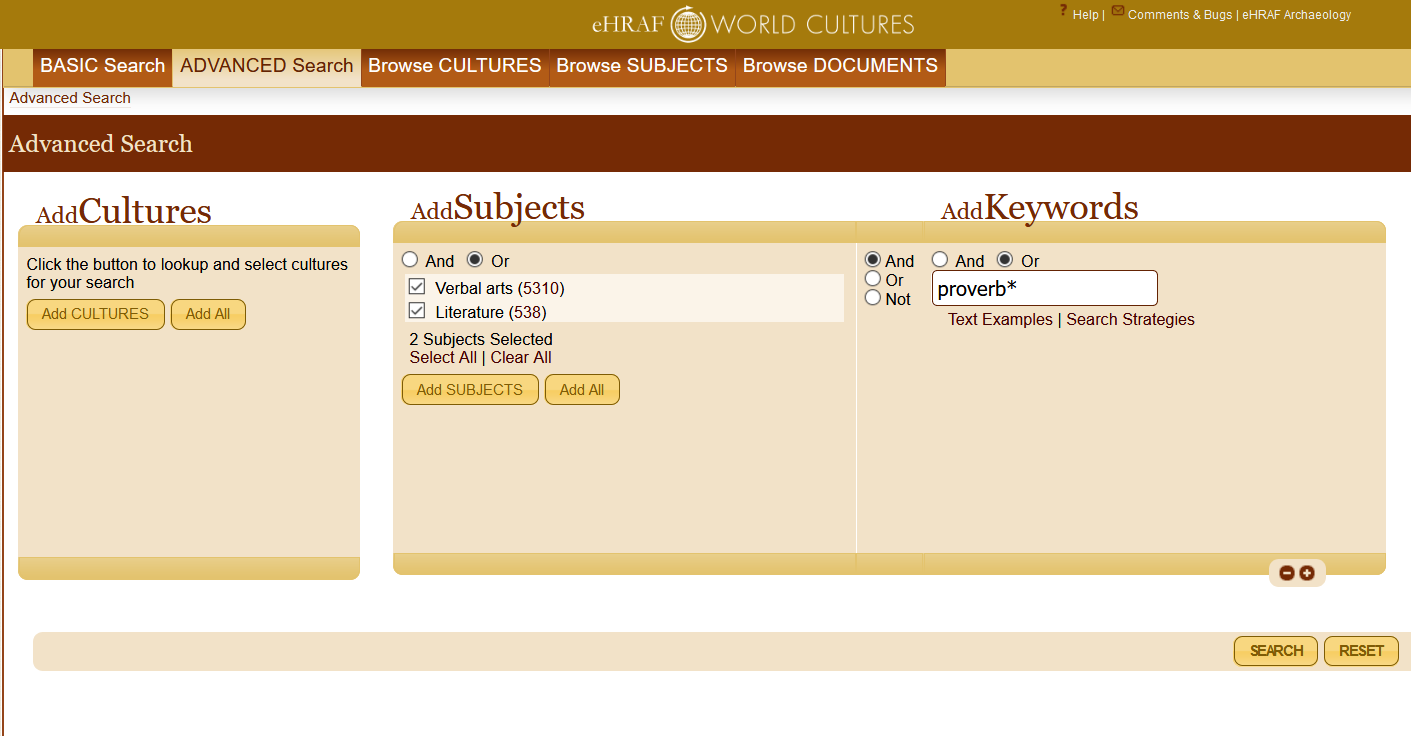By Francine Barone

Proverbs are a simple way of expressing a well-known truth or adage based on common sense or experience. They are usually considered to be imbued with ancestral wisdom, passed down from generation to generation until they become part of a society’s oral tradition. This article will explore what anthropology, archaeology, and the ethnographic record can offer to the field of paremiology, which is dedicated to the collection and study of proverbs.
A form of verbal arts or oral literature alongside poetry, songs, riddles, myths, and jokes, proverbs are typically a form of unwritten communication. Stylistically set apart from regular speech, they are often metaphorical or symbolic in nature. Speakers can use proverbs to impart knowledge, offer advice, teach or reinforce morals, make an argument, relieve interpersonal tensions, aid in understanding, or to console or inspire others.
Some popular English-language proverbs include:
- Practice makes perfect
- Ignorance is bliss
- Those who live in glass houses should not throw stones
- Don’t count your chickens before they hatch
- An apple a day keeps the doctor away
Because its significance comes “from the cultural past whose voice speaks truth in traditional terms” a proverb may serve as an effective impersonal vehicle for personal communication (Arewa and Dundes 1964: 70). For example, if parents use a proverb to scold or correct a child, they externalize this responsibility and transfer the onus onto an anonymous voice of authority from the past. Indeed, part of the rhetorical power of the proverb comes from its inherent authoritativeness as the collected wisdom of “the elders” alongside a desire to pass this knowledge down to non-elders (Yankah 1989: 71).
Unlike other verbal arts like jokes or rhymes, proverbs are not simply taught to children by repetition. They are interwoven into daily speech acts such as stories told by grandparents or instructions given by parents, and find their way into everyday conversation. However, they may also be tied to very specific places, as even speakers of the same language from different villages, towns, cities, or countries, may not recognize or interpret proverbs in the same way. As will be shown below, some proverbs may share similar meanings across cultures and languages, although translating them can be a challenge (Lubis 2018).
Since proverbs communicate shared experiences or lessons, they can tell us a great deal about the culture in which they are used (see Smith 1920: 311). Ethnographers and linguistic anthropologists in particular collect insightful data into the patterns of speaking in different places and times. Thus, while largely considered to be a subject of focus for folklorists and literature specialists, proverbs need not remain outside the consideration of anthropologists.
History repeats itself.
 Some of the earliest examples of recorded proverbs were produced by ancient Sumerian scribes. According to data found in eHRAF Archaeology, seven hundred tablets and fragments containing 15-20 compilations amounting to more than a thousand Sumerian proverbs were discovered and reconstructed by researchers (Kramer 1963: 224-225). These ancient collections of meaningful sayings dating back to at least 2,000 BCE “reveal a keen if not always flattering evaluation of the human scene and the drives and motives, the hopes and longings, and the paradoxes and contradictions which pervade it” (ibid. 225).
Some of the earliest examples of recorded proverbs were produced by ancient Sumerian scribes. According to data found in eHRAF Archaeology, seven hundred tablets and fragments containing 15-20 compilations amounting to more than a thousand Sumerian proverbs were discovered and reconstructed by researchers (Kramer 1963: 224-225). These ancient collections of meaningful sayings dating back to at least 2,000 BCE “reveal a keen if not always flattering evaluation of the human scene and the drives and motives, the hopes and longings, and the paradoxes and contradictions which pervade it” (ibid. 225).
Selected translations of these proverbs include:
- Don’t pick it now; later it will bear fruit.
- Tell a lie; then if you tell the truth it will be deemed a lie.
- Build like a lord—live like a slave; build like a slave—live like a lord.
- When walking, come now, keep your feet on the ground.
- Friendship lasts a day; kinship lasts forever.
Despite being nearly 4,000 years old, these snippets of Sumerian wisdom are surprisingly easy to understand from a contemporary perspective. Themes of common English proverbs can be recognized in these early fragments, such as: how to benefit from patience and hard work; keeping ones “feet on the ground”; blood being thicker than water; and the importance of not “crying wolf” and ruining one’s credibility. This begs the question for anthropologists: are there some proverbs that are human universal across all cultures and time?
A watched pot never boils.

Proverbs are so central in some societies that meta-proverbs exist to extol the importance of learning one’s proverbs. For the Kpelle, the largest ethnic group in Liberia, tales and proverbs are routinely used to instruct children, to support arguments, and to warn against ill-considered behavior. Stories are commonly told in the evening as children listen and learn (Cole, et al. 1971: 45-46). At story time, youngsters not only absorb the inherent morals of the elder’s tales, but are also being prepared to use the proverbs themselves to impart similar lessons to others in the future. In this way, proverbial wisdom is perpetuated across generations:
As a person progresses toward the status of an elder, he learns more stories and proverbs as well as more circumstances under which he can apply them. In addition to knowing how to use proverbs, the individual has to know when to use them. He would have to wait, for example, until he was old enough, since it is disrespectful for a young man to quote proverbs to his elders. A proverb illustrates the problem: “Sitting quietly will reveal alligator’s tricks”—only by careful watching and waiting will the young person come to understand his elders and their ways; revealing himself too soon can do no good and may be counterproductive (ibid.: 46).
Similarly, in Ghana and Côte D’Ivoire, it is a source of pride for an Akan elder when their child displays a keen proverbial eloquence, as it is considered a mark of intelligence for a child to be able to skillfully decode proverbs: “‘A wise child is addressed in idiom, not in plain words,’ goes an Akan meta-proverb” (Yankah 1989: 81). The importance of proverbs in many cultures as a key means for instructing young people in the normative rules of their society is made apparent by the elevated status afforded to those who have mastered the art of the proverb.
Don’t bite the hand that feeds you.

Like other forms of folklore and verbal arts, proverbs can be sorted into genres based on the aspect of culture that they address. For instance, some sayings focus on instilling moral provisions and prescribing justice. These serve the broader needs of society by encouraging social harmony and mutual respect.
Proverbs from the Mongo people of the Congo basin featuring themes such as obligation, respect for authority, and the importance of the family, are particularly stressed (Nelson 1994: 78), as illustrated in the following examples:
- Help received today is returned tomorrow.
- The older one is, the greater the respect.
- The young cannot teach tradition to the old.
- The health of a banana is measured in its leaves as that of the family is in its members.
- The fish does not reject its water; man must follow the family.
According to Nelson (1994: 78-9), in the absence of codified laws, proverbs such as the following often acted as the “legal precedents” for deliberations and decisions made by the Mongo council of elders:
- Before judging others, judge yourself.
- Firewood burns as long as it is not wet; A good man triumphs only when he is just.
- It is better to hunger than to steal.
The moral imperatives of the lessons included in proverbs throughout many cultures of the world speak to many common human desires for kinship, friendship, equality and justice. By encouraging the highest form of moral conduct, proverbs inspire good deeds and discourage selfishness and anti-social behavior.
In Abhkazian culture in the South Caucasus, proverbs instruct how to be a hospitable host by feeding one’s guests as is appropriate to honor their social status. It is said that “he who respects you, respects your stomach, too” (Benet 1974: 34). Yet it is not simply about providing a bountiful roast dinner. Like the members of a family, each animal and each cut of meat has a place within a hierarchy. A second Abhkazian proverb – “look at the person and then cut the meat” – derives from the traditional food practice delineating how precisely the meat should be distributed amongst guests as determined by their social position and relative status within the family.
No man is an island.

In addition to social classes, prescribed gender roles and hierarchies within a society can also be uncovered by examining popular sayings. A Badaga proverb expresses the philosophy behind bride choice in their district of Tamil Nadu, India: “Have the girl from a far-away place; have the cow from a nearby place” (Hockings 1980: 84). This curious comparison of cows and women is a succinct way of advising that classificatory cross-cousins are deemed to make the best choice of wife for Badaga men. Since such a woman will come from a more distant village, “she will be unable to run home to her parents too often; in short, she is likely to remain in the marital home and work adequately there” (ibid.) away from the competing attentions of friends and relatives.
In Pashtun society in eastern Afghanistan, the relative status of women is even more starkly revealed in this proverb: “women are but half-worth human beings” (Boesen 1980: 50). Boesen explains the root of this saying in Pashtun culture:
The relationship between the sexes, and the “status” of women in relation to men, implies that women are regarded as inferior to men and as such liable to their control. […] Women are regarded as the personal property of the men, and their chastity and “good behaviour” according to the Pashtun norms constitute a vital element in a man’s honour and his image as a “true Pashtun” (ibid).
A third ethnographic example of depictions of gender and power in proverbs comes from Serbian village lore. In the 1960s, Halpern found that old women in the village had once been practitioners of folk medicine who cured diseases and predicted the future. This made elderly women feared for their supernatural powers, embodied in the once common proverb, “Where the devil cannot cause mischief, he sends an old woman to do it for him” (1967: 203).
Conversely, in other cultures, it is actively discouraged to seek a higher status than others, and this is reflected in the popular sayings used. Both Hawaiians and the Maori disapprove of those who “act high” or think too highly of themselves. In both societies, there are many proverbs which warn against self-aggrandizement as contemptible behavior. For example, a Hawaiian proverb advises, “Stay among the clumps of grasses and do not elevate yourself” (Linnekin 1985: 136). A Maori proverb similarly cautions: “The kumara [sweet potato] does not proclaim its own sweetness” (Metge 1995: 103).
A broken clock is right twice a day.

As a predominately oral tradition, proverbs are a rich source of data for conducting an “ethnography of speaking”, a part of linguistic anthropology that focuses on the use of language in the conduct of social life (Bauman and Sherzer 1975: 96). Paremiology provides myriad opportunities for linguistic anthropologists and cultural linguists to understand the meaning behind the metaphorical turns of phrase that make up proverbs in different cultures. However, translating proverbs can be a tricky enterprise. Because language and culture are deeply intertwined, not all proverbs are universally understood across cultures. Indeed, it is impossible to understand a proverb in absence of the cultural context in which it is found.
For instance, proverbs figure prominently in the vernacular of the Rural Irish on the remote island of Inis Beag, where they are enjoyed as an eloquent way to sharpen the wits. However,
Many are subtle and cannot be understood unless the history and culture of Inis Beag and Ireland are known to the listener. Such a one is, “Come raise the bag on me.” This proverb derives from the days of the famine, when maize (corn) was distributed to the poor and hungry; an old woman on the mainland nearby with eight mouths to feed was given a one-pound sack, and she asked an official to help her with the “great load.” Now it is employed whenever someone receives less than he anticipated (Messenger 1969: 116).
Outside of the historical context of this isolated island community, this adage would be very difficult to interpret, which highlights the importance of understanding language and speech within its cultural surrounds before extrapolating cross-cultural inferences.
Are proverbs universally found in all cultures around the world? It seems that they are not. Research in eHRAF World Cultures uncovered the case of the 19th century Yaghan people of Tierra del Fuego, among whom both poetry and proverbs were entirely absent (Cooper 1946: 102). While melodic rhythms exist in the form of song, the sounds used do not have distinct meanings in the Yamana language and impromptu singing was not a popular activity (Gusinde and Schütze 1937: 1412-1413). In cultures where proverbs do not exist, what other spoken or unspoken tools might exist to fulfill the role that proverbs play in many other societies, such as imparting wisdom, knowledge, and life lessons? This is one aspect of a cross-cultural paremiology that would benefit from further anthropological research.
Strike while the iron is hot.
The above examples are just a few of the ethnographic findings on proverbs in the eHRAF World Cultures and eHRAF Archaeology databases. To conduct your own cross-cultural comparison of proverbs, try searching with the OCM identifiers Verbal arts (5310) and Literature (538).

References
Arewa, E., & Dundes, A. 1964. “Proverbs and the Ethnography of Speaking Folklore”. American Anthropologist, 66(6), 70-85. http://www.jstor.org/stable/668162
Bauman, R. and J. Sherzer. 1957. “The Ethnography of Speaking”, Annual Review of Anthropology 4(1): 95-119.
Benet, Sula. 1974. “Abkhasians: The Long-Living People of the Caucasus.” In Case Studies in Cultural Anthropology, xiv, 112. New York: Holt, Rinehart and Winston. https://ehrafworldcultures.yale.edu/document?id=ri03-005.
Boesen, Inger W. 1980. “Women, Honour and Love: Some Aspects of the Pashtun Woman’s Life in Eastern Afghanistan.” Afghanistan Journal Vol. 7 (no. 3): 50–59. https://ehrafworldcultures.yale.edu/document?id=au04-024.
Cole, Michael, John Gay, Joseph A. Glick, Donald W. Sharp, Thomas Ciborowski, Frederick Frankel, John Kellemu, and David F. Lancy. 1971. The Cultural Context of Learning and Thinking: An Exploration in Experimental Anthropology. New York: Basic Books, Inc. https://ehrafworldcultures.yale.edu/document?id=fd06-027.
Cooper, John M. 1946. “The Yahgan.” In Handbook of South American Indians, Edited by Julian H. Steward, v. 1:81–106. Washington: U.S. G.P.O. https://ehrafworldcultures.yale.edu/document?id=sh06-002.
Gusinde, Martin, and Frieda Schütze. 1937. “The Yahgan: The Life and Thought of the Water Nomads of Cape Horn.” In Die Feuerland-Indianer [The Fuegian Indians], Vol. II:HRAF: xv, 1471 [incomplete] [original: 365–1185, 1278–1499 ]. Mödling Bei Wein: Anthropos-Bibliothek. https://ehrafworldcultures.yale.edu/document?id=sh06-001.
Halpern, Joel Martin. 1967. “A Serbian Village.” In Harper Colophon Books, xxvi, 358. New York: Harper & Row. https://ehrafworldcultures.yale.edu/document?id=ef06-025.
Hockings, Paul. 1980. “Ancient Hindu Refugees: Badaga Social History 1550-1975.” In Studies in Anthropology, v. 6:14, 285. The Hague: Mouton. https://ehrafworldcultures.yale.edu/document?id=aw50-002.
Kramer, Samuel Noah. 1963. The Sumerians: Their History, Culture, and Character. Chicago: University of Chicago Press. https://ehrafarchaeology.yale.edu/document?id=mh64-004.
Lubis, Syahron. 2019. “The Universality and Uniqueness of Proverb and Its Impact on Translation”. 10.2991/eltlt-18.2019.53.
Messenger, John C. (John Cowan), George Dearborn Spindler, and Louise S. Spindler. 1969. “Inis Beag: Isle of Ireland.” In Case Studies in Cultural Anthropology, 8, 136. New York: Holt, Rinehart and Winston. https://ehrafworldcultures.yale.edu/document?id=er06-016.
Metge, Joan. 1995. New Growth from Old: The Whanau in the Modern World. Wellington, N.Z.: Victoria University Press. https://ehrafworldcultures.yale.edu/document?id=oz04-011.
Nelson, Samuel Henry. 1994. “Colonialism in the Congo Basin, 1880-1940.” In Monographs in International Studies. Africa Series, xii, 279. Athens, Ohio: Ohio University Center for International Studies. https://ehrafworldcultures.yale.edu/document?id=fo32-010.
Smith, Edwin William, and Dale, Andrew Murray, d. 1919. 1920. The Ila-Speaking Peoples of Northern Rhodesia: Vol. 2. London: MacMillan and Co. https://ehrafworldcultures.yale.edu/document?id=fq06-002.
Yankah, Kwesi. 1989. “The Proverb in the Context of Akan Rhetoric: A Theory of Proverb Praxis.” In Sprichwörterforschung, 313. Bern: P. Lang. https://ehrafworldcultures.yale.edu/document?id=fe12-055.